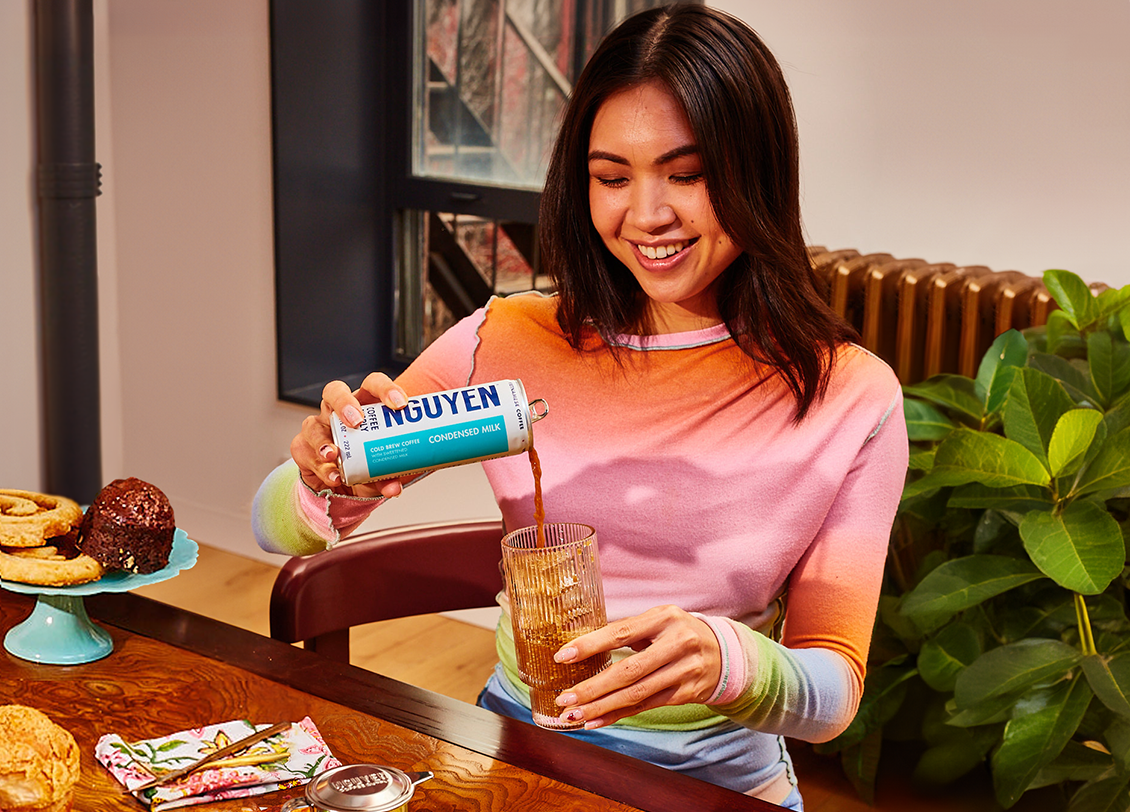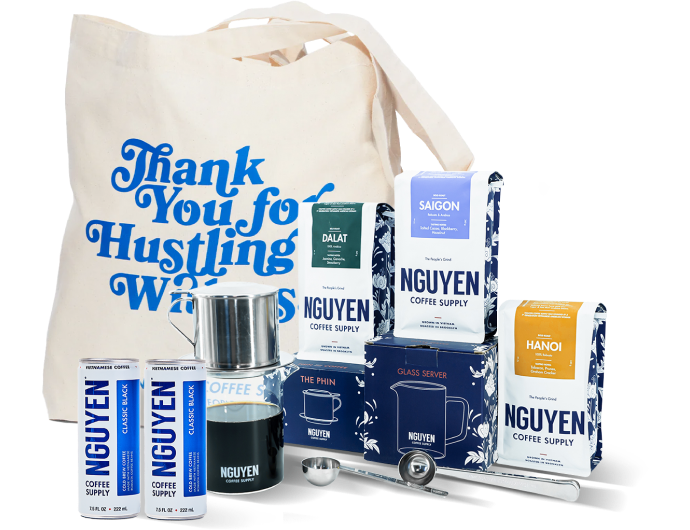


Create for yourself or as a gift for your loved ones
Subscribe nowMe and mom just enjoyed the Nguyen phin drip experience. Wow. Proud of your work. We without hesitation enjoy the Vietnamese coffee and recommend your products. Thank-you to the Nguyen staff and tradition. From Canada eh!
All about condensed milk
Always delicious (even spooned straight from the can – shhh, it’s a guilty pleasure!), condensed milk is a shelf-stable but versatile ingredient that is a must have in kitchens around the world. From Asia to Africa to the Americas, this unique ingredient adds flavor and texture to desserts, cakes, toppings, sauces, yogurts, ice creams, and drinks that range from hot chocolate to Vietnamese iced coffee.
How is sweetened condensed milk made?
Often called sweetened condensed milk, this creamy treat is concentrated by removing about 60% of the water content from fresh milk. Rich, thick, and slightly golden, it is then sweetened with 40% to 45% sugar before it is canned. When simply condensed without sweetening, this product is called evaporated milk.
History of sweetened condensed milk
We all know how quickly fresh milk can sour in warmer weather, particularly when refrigeration is not easily available. Back in the early 1800s, French food preservation scientist Nicolas Appert found a solution to this problem: he boiled fresh unsweetened milk in an open pan and then preserved it in a sealed container that was then heated.
He was followed by British merchant Peter Durand, who invented and patented (in 1810) his own method of preserving food, the tin cans. Meanwhile, U.S. entrepreneur Gail Borden Jr was experimenting with ways of safeguarding food supplies through more effective conservation and preservation. With refrigeration technology still in its infancy, he focused on developing long-life food items, particularly through dehydration and concentration. Although his dried beef biscuits flopped with consumers, his evaporated milk proved popular. Protected by British and UK patents issued in 1853 and pumped up by the American Civil War, demands for his products rose rapidly, expanding into processes for condensing fruit juices, beef extracts, and coffee.
In Europe, the Anglo-Swiss Condensed Milk Company was established in 1866 with help from U.S. brothers Charles and George Page. Making good use of Switzerland’s abundant fresh milk supplies, they set up Europe’s first condensed milk factory, providing a rapidly industrializing Europe with a safe and long-life alternative to fresh milk under a brand that is still familiar today: Milkmaid.
As cities expanded, steamships and railroads spurred international trade in consumer goods, lowering commodity prices to levels affordable by the masses. In 1905, Anglo-Swiss merged with the baby food firm set up by Henri Nestlé, forming the initial core of a conglomerate whose products are sold worldwide via the Nestlé Group
Condensed milk and coffee in Vietnam
Under French colonial rule (1884 – 1954), Vietnam absorbed many aspects of European culture. With a hot and humid climate that was perfect for growing coffee and a dairy industry that was still incipient until World War I, this combination opened up a market hungry for canned condensed milk. By the 1920s, the French habit of chatting for hours over cups of sweet and creamy Vietnamese coffee – preferably iced – was firmly entrenched, particularly at the Sofitel Legend Metropole Hotel in Hanoi.
From there, it spread to the Vietnamese people, soon becoming an integral part of the nation’s culture, sweetening the intense but bitter flavor of the local robusta slow drip with creamy swirls of canned sweetness.
In fact, Vietnam is the world’s largest Robusta coffee grower, ranking second worldwide for coffee production in general. With double the caffeine in robusta beans, Vietnamese coffee is renowned as a powerful energy jolt. Vietnam’s output also includes citrusy typica beans (an arabica offshoot) grown at higher altitudes. Originally developed in Portugal in 1959, the Catimor varietal is another high-yield hybrid whose beans release a nutty, herbal aroma, with distinct cherry and berry notes.
Because of their local growing conditions, Vietnamese robusta coffees often have bolder, deeper flavors with nuttier profiles, compared to beans grown in other parts of the world. With 60% less sugar and fats than arabica coffees, they also have higher antioxidant properties. Simultaneously sweet and savory, refreshing and earthy, with hints of chocolate and nuts, traditional cà phê sữa đá has an unmistakably rich mouthfeel.
Preparing Vietnamese iced coffee (cà phê sữa đá) takes time. However, watching that fragrant black liquid drip through a stainless steel phin filter and pool on the gooey dollop of condensed milk filling the bottom of the glass is a gastronomic ritual that cannot be hurried. Next comes a quick swirl that cuts the coffee bitterness with creamy sweetness, making a drink that is served piping hot or refreshingly cold over ice. Phin filters are a must to get that full robusta flavor. The traditional phin is divided into three sections: a filter chamber, a gravity press or screw-on press, and a lid that doubles as a saucer, avoiding coffee grounds and water pooling on the table once brewing is complete.
Condensed milk in the USA today
Despite their similar packaging, sweetened condensed milks can vary significantly in terms of ingredients, with different flavors, textures and creaminess. Some contain only sugar and full-cream milk, while others are ‘filled’: a blend of skimmed milk with added vegetable oils.
Customers walking into any supermarket are spoiled for choices when it comes to canned dairy products. The shelves are packed with brands like Eagle, Longevity, Parrot, Magnolia, Carnation, and Baker’s Corner, many made by household names that are respected worldwide for their quality. There are also specialty brands – like Santini Foods and Nature’s Charm – that cater to specific markets with dietary restrictions.
We’ve reviewed each brand to help YOU pick your favorites:
Budget-friendly nutrition
With prices starting at under a dollar a can, sweetened condensed milk is a staple in many homes, particularly with children. Energy-dense and high in sugar, this nourishing treat also contains protein, fat, and a range of minerals and vitamins.
A single ounce (two tablespoons) generally contains over two grams of protein, and significant percentages of other nutrients measured by the Reference Daily Intake: around 8% calcium; 10% phosphorus; 7% selenium and riboflavin; and 4% Vitamin B12 and choline.
Homemade condensed milk
There’s no need to panic if that last can of condensed milk has somehow (check for sticky fingerprints!) vanished from the larder and the stores are closed. It’s easy to make this sweet treat at home in an ordinary saucepan, using fresh, evaporated, powdered or plant-based milks.
A regular 14 ounce can of sweetened condensed milk can be replaced in any recipe with a large cup of these luscious do-it-yourself versions, which can be frozen or stored in the refrigerator for up to six months.
Here’s how to make your own sweetened condensed milk:
Chef’s Treat: when blending the sugar and milk, add a pat of butter, a spoonful of honey or maple syrup, a few drops of vanilla essence, a sprinkle of cinnamon or a little nutmeg for extra flavor.
Does the condensed milk brand make a difference?
Some diehard Vietnamese coffee fans claim that most brands of condensed milk are too sweet and not creamy enough to balance the powerful flavor of phin filter Vietnamese coffee. However, demographics play an important role here as different ethnicities have traditional ways of using condensed milk, preferring different degrees of sweetness. Throughout Latin America, flan is a family favorite, while no party in Brazil is complete without brigadeiros, all of which use condensed milk as a main ingredient.
Blended with whipping cream and fresh fruit, sweetened condensed milk is the perfect ingredient for home-made ice creams, smoothies and yogurts. The list is endless and global! And all these sweet treats lead to a single conclusion: there’s no such thing as the best condensed milk – because they’re all delicious in their own right and are subject to personal preference! Our best advice? Try several kinds before deciding which is your personal perfect!
Learn how to brew other fun coffee drinks using Vietnamese coffee here.